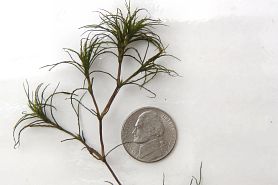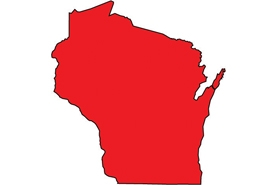Brittle Naiad
(Najas minor)
 Photo credit: Paul Skawinski, Aquatic Plants of the Upper Midwest
Photo credit: Paul Skawinski, Aquatic Plants of the Upper MidwestBrittle naiad is a submersed aquatic plant native to Europe, northern Africa, and western Asia. It was introduced to North America in the early 20th century and is primarily found in the Northeast, South, and Midwest regions within the United States. In Wisconsin, brittle naiad was first located in 2007 in Storrs Lake (Rock County). It has since been verified in a few other inland lakes, Lake Michigan, and the Mississippi River. Brittle naiad primarily reproduces through seeds but can also propagate through fragmentation. Seeds and fragments can be spread to other waterbodies by waterfowl or hitchhiking on boats/trailers.
Other names for this plant include:
- Common names: brittle waternymph, minor naiad, lesser naiad, brittleleaf naiad, eutrophic waternymph.
Classification in Wisconsin: Prohibited
- Ecological and Socio-economic Impacts
-
- In some waterbodies, brittle naiad can form large vegetation mats that impede recreational activities like fishing, boating, and swimming. However, nuisance-level growth has not been observed in Wisconsin.
- It is tolerant of turbidity and eutrophic conditions, which may allow it to outcompete native naiads (Najas spp.) and other native aquatic plants.
- Identification
-
Leaves: Thin and curved with visible spines along the margins; often ¼ to 1 ½ inches long and 1⁄16 inches wide. Leaves are arranged in pairs (opposite), although they may appear whorled.
Flowers: Tiny (⅛ inch long), 1-2 per axil.
Seeds: Tiny (1⁄16 - ⅛ inch long), present in leaf axils.
Roots: Slender, branched, and fibrous.
Similar species: Other naiad species (Najas spp.), such as slender naiad (N. flexilis), southern naiad (N. guadalupensis), and northern naiad (N. gracillima). None of the native naiads have spines along the leaf margins that are easily visible without magnification. Another naiad species that is present in Wisconsin, spiny naiad (N. marina), also has visible spines along the leaf margins but can be distinguished from brittle naiad by the additional presence of spines on the underside on the leaves, as well as along the stem.
- Distribution
-
See the reported locations of brittle naiad in Wisconsin.
Do you know of other populations? Please send us a report.
- Control
-
Prevention: The best way to keep a lake free of brittle naiad is to prevent its establishment. Wisconsin's invasive species law prohibits the transport of aquatic plants, live animals and water from a waterbody, with some exceptions for bait.
- Before leaving the boat launch, conduct the following actions required by law:
- Inspect and remove aquatic plants and animals from boats and equipment.
- Drain all water from the boat and equipment.
- Before entering another waterbody:
- Spray boat and equipment with high-pressure hot water, or
- Allow the boat and equipment to dry out of water for at least five days.
Mechanical: If brittle naiad is causing a navigational impairment, it can be mitigated through automatic cutting, raking, or hand-harvesting. However, after control efforts, brittle naiad produces many tiny seeds that remain in the sediment. It can also reproduce through plant fragments created by cutting or raking. Therefore, brittle naiad is unlikely to be eradicated through mechanical control. An approved Chapter NR 109 permit is required to use automatic control for aquatic plants in a Wisconsin waterbody.
Chemical: Herbicides that are approved for aquatic use in Wisconsin and are labeled to control naiads include 2,4-D, diquat, endothall, flumioxazin, and fluridone. However, due to the large seed bank (i.e., the stored seeds within the sediment) that brittle naiad can produce, the longevity of chemical control is likely to be very short-term, and complete eradication is very unlikely. An approved Chapter NR 107 permit is required to use herbicides in a Wisconsin waterbody to control aquatic plants.
- Before leaving the boat launch, conduct the following actions required by law:
- Resources


